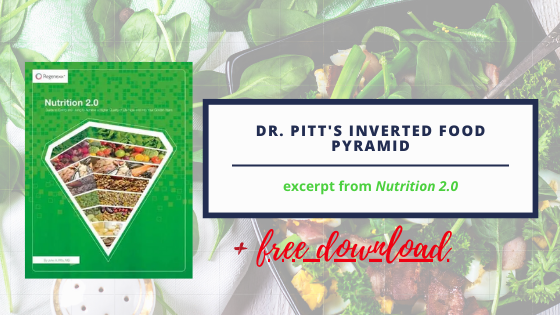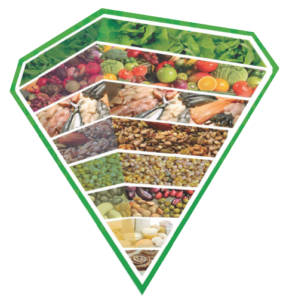Chapter 3: Bringing the Nutrition Information Together [Excerpt]
So What Do I Eat and Drink?
First, disregard the food pyramid, and take no health advice from the media. The current food pyramid is outdated, and research shows it offers no protection against chronic diseases. In a nutshell, you should eat whole foods (closest to their natural state) and less of everything else. You can have a moderate amount of organic, grass-fed, free-range meat products if you choose. Minimize highly processed, refined sugars, hydrogenated oils, vegetable oils, conventionally raised beef and pork, and grains. This is not a restrictive diet plan. These recommendations propose that you expand your diet and replace less nutritious food with more nutritious food. If you eat more nutritiously overall, you can eat anything in moderation. See my Inverted Pyramid below. Eat liberally the foods in the top 2 sections of the pyramid, eat in moderation the foods in the middle four sections, and limit or eat sparingly the foods in the bottom two sections.
Dr. Pitt’s Inverted Food Pyramid
For those of you that are young and/or do not have any chronic diseases, it would still benefit you to follow these recommendations as preventative measures. Prevention is far easier than reversing disease, so you probably can have great benefits with modest changes. However, if you suffer with one or more chronic diseases, you will likely need to embrace more changes to see more benefits. I suggest that everyone adopt these habits until the point that it makes you personally feel content and happy with your health.
All the advice I offer in this guide applies to children as well. We all see the rise in childhood obesity, type 2 diabetes, attention disorders, etc. These are directly related to poor nutrition and poor lifestyle choices. The effect of diet on children even starts when you are pregnant. Eating poorly during pregnancy can negatively affect the fetus. It has been shown that high sugar intake during pregnancy can prime the child toward craving sweets. Once the child is born, breast-feeding from a healthy mother is the best source of nutrition. If you have to use formula or a combination, then you have to be sure to avoid soy formulas and those with added high-fructose corn syrup and sugar. Lastly, start teaching children about healthy eating and lifestyle as early as possible. Explain to them the benefits, and guide them to make more healthy choices. This will take some creativity and experimenting with what healthy foods your child will enjoy. Lead by example.
Cook more if you have time, and buy organic if your budget allows. Non-organic whole plant-based foods are still a healthy option and better than processed foods and conventional animal products. Be careful of “low fat,” “all natural,” “diet,” and “organic” snacks as they may still have very poor nutrition content due to processing, the addition of extra sugar, chemical additives, and the removal of most of the natural components. Removing chemicals from an already unhealthy food does not make it much better for you, nor does the substitution of sugar for fat. Fat at least has the benefit of making you feel full so you may not eat as much, and it does not spike your blood sugars. Foods stripped of their natural nutrients and then fortified with vitamins are not healthy.

